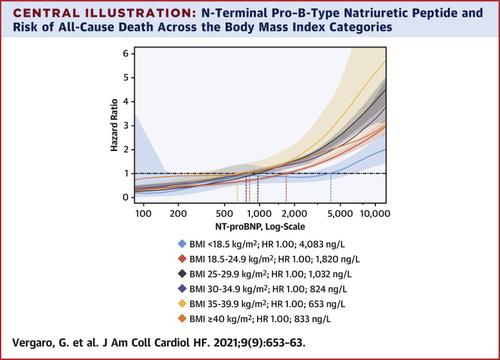JACC: Heart Failure ( IF 13.0 ) Pub Date : 2021-07-07 , DOI: 10.1016/j.jchf.2021.05.014 Giuseppe Vergaro 1 , Francesco Gentile 2 , Laura M G Meems 3 , Alberto Aimo 4 , James L Januzzi 5 , A Mark Richards 6 , Carolyn S P Lam 7 , Roberto Latini 8 , Lidia Staszewsky 8 , Inder S Anand 9 , Jay N Cohn 10 , Thor Ueland 11 , Lars Gullestad 12 , Pål Aukrust 13 , Hans-Peter Brunner-La Rocca 14 , Antoni Bayes-Genis 15 , Josep Lupón 15 , Akiomi Yoshihisa 16 , Yasuchika Takeishi 16 , Michael Egstrup 17 , Ida Gustafsson 17 , Hanna K Gaggin 18 , Kai M Eggers 19 , Kurt Huber 20 , Greg D Gamble 21 , Lieng H Ling 22 , Kui Tong Gerard Leong 23 , Poh Shuah Daniel Yeo 24 , Hean Yee Ong 25 , Fazlur Jaufeerally 26 , Tze P Ng 22 , Richard Troughton 5 , Robert N Doughty 21 , Gerry Devlin 27 , Mayanna Lund 28 , Alberto Giannoni 1 , Claudio Passino 1 , Rudolf A de Boer 3 , Michele Emdin 1

|
Objectives
The goal of this study was to assess the predictive power of N-terminal pro–B-type natriuretic peptide (NT-proBNP) and the decision cutoffs in heart failure (HF) across body mass index (BMI) categories.
Background
Concentrations of NT-proBNP predict outcome in HF. Although the influence of BMI to reduce levels of NT-proBNP is known, the impact of obesity on prognostic value remains uncertain.
Methods
Individual data from the BIOS (Biomarkers In Heart Failure Outpatient Study) consortium were analyzed. Patients with stable HF were classified as underweight (BMI <18.5 kg/m2), normal weight (BMI 18.5-24.9 kg/m2), overweight (BMI 25-29.9 kg/m2), and mildly (BMI 30-34.9 kg/m2), moderately (BMI 35-39.9 kg/m2), or severely (BMI ≥40 kg/m2) obese. The prognostic role of NT-proBNP was tested for the endpoints of all-cause and cardiac death.
Results
The study population included 12,763 patients (mean age 66 ± 12 years; 25% women; mean left ventricular ejection fraction 33% ± 13%). Most patients were overweight (n = 5,176), followed by normal weight (n = 4,299), mildly obese (n = 2,157), moderately obese (n = 612), severely obese (n = 314), and underweight (n = 205). NT-proBNP inversely correlated with BMI (β = –0.174 for 1 kg/m2; P < 0.001). Adding NT-proBNP to clinical models improved risk prediction across BMI categories, with the exception of severely obese patients. The best cutoffs of NT-proBNP for 5-year all-cause death prediction were lower as BMI increased (3,785 ng/L, 2,193 ng/L, 1,554 ng/L, 1,045 ng/L, 755 ng/L, and 879 ng/L, for underweight, normal weight, overweight, and mildly, moderately, and severely obese patients, respectively) and were higher in women than in men.
Conclusions
NT-proBNP maintains its independent prognostic value up to 40 kg/m2 BMI, and lower optimal risk-prediction cutoffs are observed in overweight and obese patients.
中文翻译:

NT-proBNP 用于心力衰竭风险预测
目标
本研究的目的是评估 N 末端 B 型利钠肽前体 (NT-proBNP) 的预测能力和跨体重指数 (BMI) 类别的心力衰竭 (HF) 的决策截止值。
背景
NT-proBNP 浓度可预测 HF 的结果。虽然 BMI 对降低 NT-proBNP 水平的影响是已知的,但肥胖对预后价值的影响仍不确定。
方法
分析了来自 BIOS(心力衰竭门诊研究中的生物标志物)联盟的个人数据。稳定型心衰患者分为体重过轻(BMI <18.5 kg/m 2)、体重正常(BMI 18.5-24.9 kg/m 2)、超重(BMI 25-29.9 kg/m 2)和轻度(BMI 30-34.9 kg/m 2)、中度(BMI 35-39.9 kg/m 2)或严重(BMI ≥40 kg/m 2)肥胖。NT-proBNP 对全因和心源性死亡终点的预后作用进行了测试。
结果
研究人群包括 12,763 名患者(平均年龄 66 ± 12 岁;25% 女性;平均左心室射血分数 33% ± 13%)。大多数患者超重(n = 5,176),其次是体重正常(n = 4,299)、轻度肥胖(n = 2,157)、中度肥胖(n = 612)、重度肥胖(n = 314)和体重不足(n = 205) )。NT-proBNP 与 BMI 呈负相关(β = –0.174 for 1 kg/m 2 ; P <0.001)。将 NT-proBNP 添加到临床模型可改善 BMI 类别的风险预测,但严重肥胖的患者除外。5 年全因死亡预测 NT-proBNP 的最佳截断值随着 BMI 增加而降低(3,785 ng/L、2,193 ng/L、1,554 ng/L、1,045 ng/L、755 ng/L 和 879 ng /L,分别适用于体重过轻、正常体重、超重和轻度、中度和重度肥胖患者),女性高于男性。
结论
NT-proBNP 保持其独立预后值高达 40 kg/m 2 BMI,在超重和肥胖患者中观察到较低的最佳风险预测临界值。



























 京公网安备 11010802027423号
京公网安备 11010802027423号